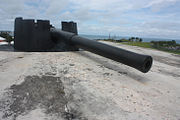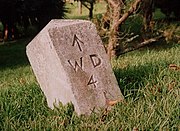
Bermuda Regiment recruits in 1993
The defence of Bermuda remains the responsibility of the National (British) Government, rather than of the Bermudian Government, which is effectively a local authority. Despite this, the Bermuda Government was historically responsible for maintaining Militia for the defence of the Colony. As Bermuda became the primary Royal Navy headquarters and dockyard in the Western Atlantic, following American independence, there was a parallel build-up of military defences to protect the naval base. Seeing the militia as having become superfluous, with the large number of regular soldiers then present, the Colonial Government allowed it to lapse after the American War of 1812, however, it did raise volunteer units at the end of the Century to form a reserve for the military garrison.
Following the loss of Britain's ports in thirteen of its former continental colonies after the American War of Independence, Bermuda assumed a new strategic prominence for the Royal Navy. When Hamilton, a centrally located port founded in 1790, became the seat of government in 1815, it was partly resultant from the Royal Navy having invested twelve years, following American independence, in charting Bermuda's reefs. It did this in order to locate the deepwater channel by which shipping might reach the islands in, and at the West of, the Great Sound, which it had begun acquiring with a view to building a naval base. However, that channel also gave access to Hamilton Harbour. The Royal Navy had originally invested in property around St. George's, but slowly moved all of its operations to the West End once the channel had been charted. In addition to serving as a naval base and coalling station for its North America & West Indies Squadron, the Royal Navy developed Bermuda as its only dockyard between the Canadian Maritimes and the West Indies where major repairs to large vessels could be made. It was initially the winter headquarters of the Admiralty based in the Maritimes, but became the year-round headquarters during the course of the century. The blockade of the southern US Atlantic Seaboard, as well as the sack of Washington D.C., carried out during the American War of 1812 was orchestrated from the Admiralty House in Bermuda, then located at Mount Wyndham, in Bailey's Bay [1].

A Bermuda Regiment Corporal
Prior to the American War of Independence, the only Regular Army unit in Bermuda was an Independent Company, based in St. George's. With the buildup of the Royal Naval establishment in the first decades of the Nineteenth Century, a large number of military fortifications and batteries were constructed, and the numbers of regular infantry, artillery, and support units that composed the British Army garrison were steadily increased. The investment into military infrastructure by the War Office proved unsustainable, and poorly thought-out, with far too few artillery men available to man the hundreds of guns emplaced. Rapid technological advance in artillery rendered many of the forts obsolete before they were completed, and several were abandoned, or removed from use, soon after construction. Following the Crimean War, the trend was towards reducing military garrisons in colonies like Bermuda, partly for economic reasons, and partly as it became recognised that the Royal Navy's own ships could provide a better defence for the Dockyard, and Bermuda. Still, the important strategic location of Bermuda meant that the withdrawal, which began, at least in intent, in the 1870s, was carried out very slowly over several decades, continuing until after the Great War. The last Regular Army units were not withdrawn until the Dockyard itself closed in the 1950s. In the 1860s, however, the major build-up of naval and military infrastructure brought vital money into Bermuda at a time when its traditional (cedar- and sail cloth-based) maritime industries were giving way under the assault of steel hulls and steam propulsion. The American Civil War, also, briefly, provided a shot-in-the-arm to the local economy. Tourism and agricultural industries would develop in the latter half of the nineteenth Century, however, it was defence infrastructure that formed the central platform of the economy into the Twentieth Century.

The defunct St. David's Battery (also known as the Examination Battery), on St. David's Island, in 2011
The Colony's prominence as a naval station was underlined during both world wars thanks of its location in the North Atlantic Ocean, its naturally-protected waters, and the presence of the Royal Naval Dockyard and its military defences. With the US, the primary threat to Bermuda in the Nineteenth Century, becoming an ally in both wars, US forces began to make use of Bermuda also.

US Army camp at Turtle Hill Bermuda in WWII
The US had operated a US Naval station on the island during the latter stages of the World War I to serve anti-submarine vessels crossing to the European war zone, and US Navy vessels had also used the island, which was a hub for trans-Atlantic convoys. This involvement of the allied US forces in Bermuda was built upon in the Second World War. Before the USA had entered that conflict, the British Government had granted it a free, 99-year base lease in Bermuda, along with a similar grant in Newfoundland for what became the Ernest Harmon Air Force Base. These grants were an extension of the Lend-Lease agreement, but not actually part of it, and no loan of ships or other war material was received in return (although the agreement for the airfield to be constructed in Bermuda was that it be shared with the Royal Air Force). The US Army and the US Navy both began construction of air stations (an airfield and a flying boat station, respectively) in 1941, and the USA operated these bases until the end of the Cold War. The bases consisted of 5.8 km² (2.25 mi²) of land, largely reclaimed from the sea.
The US bases were not the only, or even the first, air stations operating in Bermuda, however. The civil airport, a flying boat station on Darrell's Island, was taken over by the RAF at the start of the war, and used by two commands. The government airline, Imperial Airways/BOAC, which had operated Darrell's Island before the war, adopted its war time role, and its camouflaged flying boats maintained trans-Atlantic service through Bermuda throughout the war. US Navy aircraft also briefly operated from Darrell's Island, maintaining anti-submarine air parols, before their own base was operational. Before the US entry into the war, anti-submarine air patrols were flown on an ad-hoc basis by the Walrus flying boats of the Royal Navy's Fleet Air Arm, operating from its own base on Boaz Island.

War Department Ordnance Survey Marker, Bermuda.
With the build up of the US bases on the island, the enduring alliance post-war, under NATO, Britain's re-assessment of its global military role and responsibilities in light of subsequent break up of the British Empire, and its near bankruptcy from the cost of the war, the value placed on the Imperial bases in Bermuda rapidly diminished on the end of the conflict.
The Royal Naval dockyard and the attendant military garrison were closed during the 1950s. A small supply base, HMS Malabar, continued to operate within the Dockyard until it, too, was closed, along with the American and Canadian bases, in 1995. The US bases closed on 1 September of that year, but unresolved issues - primarily related to environmental factors - delayed the formal return of the base lands to the Government of Bermuda, which finally occurred in 2002. The only military units remaining in Bermuda, today, are the Bermuda Regiment, an amalgam of the voluntary units formed in the 19th Century, and army and naval cadet corps.
Military branches[]
- The Bermuda Regiment
- Bermuda Police Service
- Bermuda Reserve Police
- Airport Security Police
- Bermuda Cadet Corps
- Bermuda Sea Cadet Corps
Military expenditures 2005/06 (Revised) - dollar figure: $5,687,000 (Defence), $50,467,000 (Police).
Military expenditures - percent of GDP: 0.11 NA% (Not including Police).
Military - note: defence of Bermuda is the responsibility of the United Kingdom
Adapted from the CIA World Factbook 2000.
See also Government of Bermuda Budget Statement 2006/07 (pdf file).
[]
- Royal Naval Dockyard Bermuda, and the Royal Navy in Bermuda 1795-1995.
- Royal Navy (Fleet Air Arm), Royal Naval Air Station Boaz Island (HMS Malabar) 1939-1943.
- British Army, Bermuda Garrison. 1701-1957.
- Bermuda Militia. 1612-1815.
- Locally-raised Volunteer and Territorial Army Units. 1895-1965.
- Royal Air Force, RAF Darrell's Island. 1939-1945.
- Royal Air Force, Kindley Field. 1943-1945
- Royal Canadian Navy, HMCS Somers Isles. 1944-1945.
- Royal Canadian Navy, Naval Radio Station Bermuda. 1944-1968.
- Canadian Forces Station Bermuda, Daniel's Head. 1968-1993.
Former US Bases In Bermuda[]
- United States Naval Station, Base 24, on White's Island, Bermuda. The Great War.
- United States Supply Station, Bermuda at Agar's Island. First World War.
- US Naval Operating Base, Naval Station Bermuda, Naval Air Station Bermuda, and NAS Bermuda Annex. 1941-1995.
- United States Navy Submarine Base, Ordnance Island. Second World War.
- United States Navy, Naval Facility Bermuda. (Tudor Hill) 1954-1995.
- United States Army Bermuda Garrison. 1941-1945.
- United States Army, Fort Bell. 1941-1948
- United States Army Air Forces, Kindley Field. 1943-1948.
- United States Air Force, Kindley Air Force Base. 1948-1970.
- United States Navy, Naval Air Station Bermuda (originally Kindley Field) 1970-1995.
- United States Coast Guard Air-Sea Rescue, at Naval Station Bermuda and Kindley AFB
- National Air and Space Administration, at Kindley AFB/US NAS Bermuda
Bibliography[]
- Defence, Not Defiance: A History Of The Bermuda Volunteer Rifle Corps, Jennifer M. Ingham (now Jennifer M. Hind), The Island Press Ltd., Pembroke, Bermuda, ISBN 0-9696517-1-6
- The Andrew And The Onions: The Story Of The Royal Navy In Bermuda, 1795–1975, Lt. Commander Ian Strannack, The Bermuda Maritime Museum Press, The Bermuda Maritime Museum, P.O. Box MA 133, Mangrove Bay, Bermuda MA BX. ISBN 0-921560-03-6
- Bermuda Forts 1612–1957, Dr. Edward C. Harris, The Bermuda Maritime Museum Press, The Bermuda Maritime Museum, ISBN 0-921560-11-7
- Bulwark Of Empire: Bermuda's Fortified Naval Base 1860-1920, Lt.-Col. Roger Willock, USMC, The Bermuda Maritime Museum Press, The Bermuda Maritime Museum, ISBN 0-921560-00-1
- Flying Boats Of Bermuda, Sqn.-Ldr. Colin A. Pomeroy, Printlink, PO Box 937, Hamilton, Bermuda HM DX, ISBN 0-9698332-4-5
- Bermuda From Sail To Steam: The History Of The Island From 1784 to 1901, Dr. Henry Wilkinson, Oxford University Press, ISBN 0-19-215932-1
External links[]
- POTSI (archived): Bermuda Military History Index
- POTSI (archived): Bermuda Regiment
- POTSI (archived): Bermuda's First World War Roll of Honour
- POTSI (archived): Bermuda's Second World War Roll of Honour
- POTSI (archives): THE GREAT WAR - BERMUDIANS IN IMPERIAL(LESS LOCAL) UNITS, AND IN ALLIED FORCES.
- Bermuda Cadet Corps
- Bermuda Sea Cadet Corps
- Bermuda Online: Royal Navy in Bermuda, Pre-1900
- Bermuda Online: Royal Navy in Bermuda, 1900-1995
- Bermuda Online: Fortifications in Bermuda
- Bermuda Online: Regiments and Army Units stationed in Bermuda
- Bermuda Online: Canadian Forces in Bermuda
- Bermuda Online: American Forces in Bermuda
- Bermuda Online: War Veterans of Bermuda
| ||||||||
The original article can be found at Military of Bermuda and the edit history here.